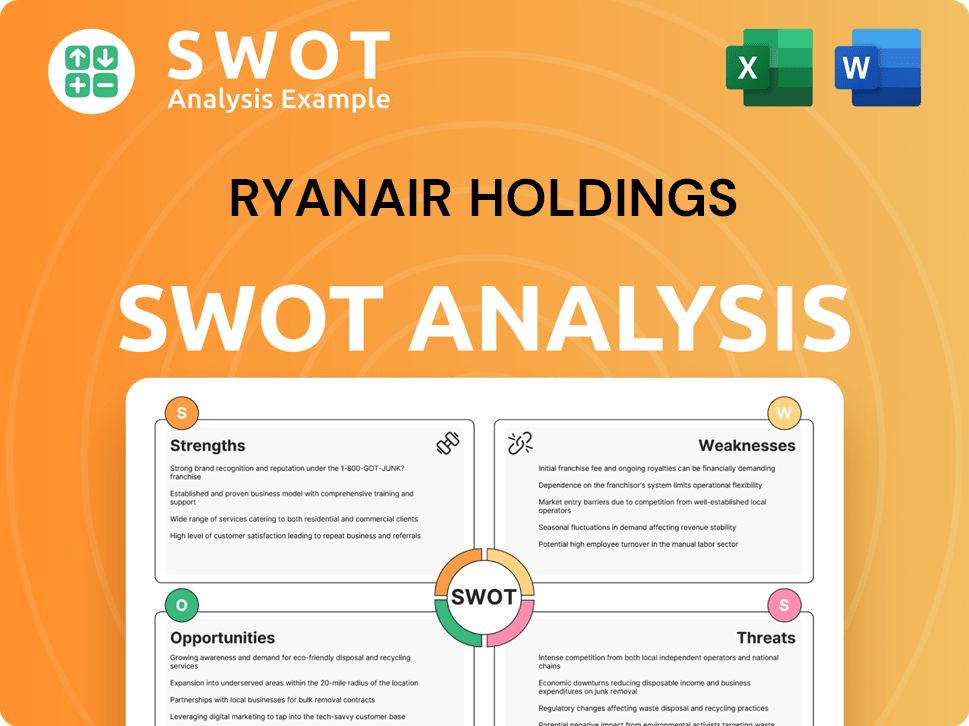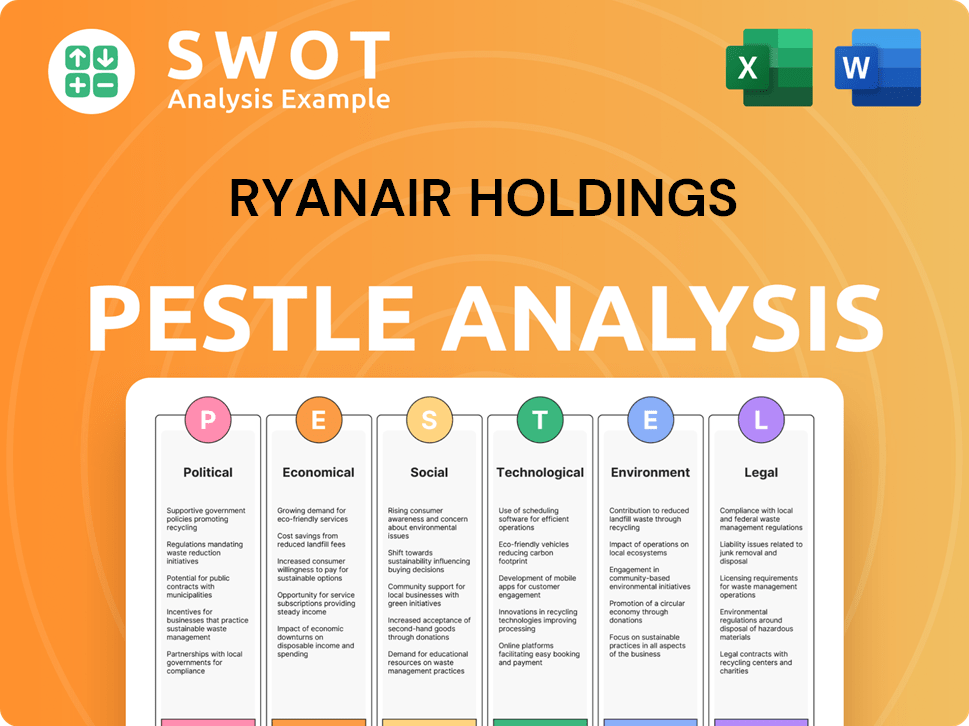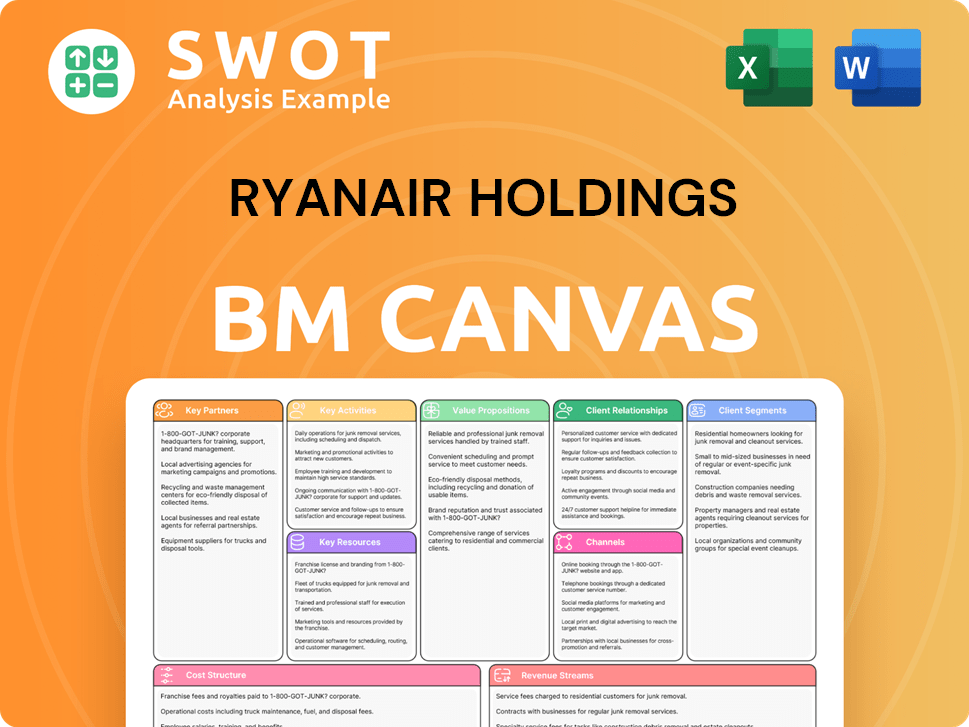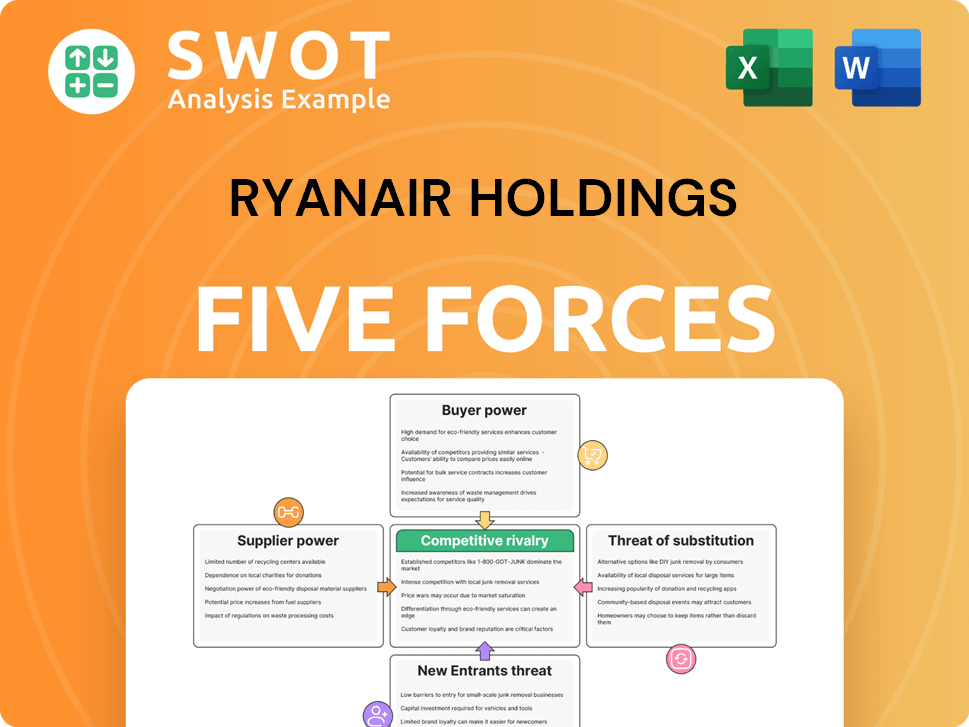Ryanair Holdings Bundle
Can Ryanair Maintain Its Dominance in the Cutthroat Airline Industry?
Ryanair Holdings, a titan of the low-cost carrier model, continues to make waves in the aviation sector. Its impressive financial performance, with a substantial profit in fiscal year 2024, underscores its resilience and strategic prowess. But what does the Ryanair Holdings SWOT Analysis reveal about its competitive positioning?

This in-depth exploration of Ryanair's competitive landscape will dissect its strategies, analyze its key rivals, and evaluate its market share in 2024. We'll examine how Ryanair competes, including its business model analysis, and how it navigates challenges like fluctuating fuel prices. Understanding Ryanair's strategic positioning is crucial for anyone seeking to understand the future of the airline industry and the dynamics of low-cost carriers.
Where Does Ryanair Holdings’ Stand in the Current Market?
Ryanair Holdings maintains a dominant market position within the European airline industry. It is primarily recognized as Europe's largest airline group by passenger numbers. The company's core operations focus on scheduled passenger airline services, particularly short-haul, point-to-point routes. This strategy allows for high efficiency and cost-effectiveness, which is a key factor in the Ryanair competitive landscape.
The value proposition of Ryanair centers on providing affordable and direct connections. This is achieved through a low-cost carrier model, avoiding the complexities of hub-and-spoke systems. This approach enables Ryanair to offer competitive fares, attracting a large volume of budget-conscious travelers. For those seeking more information, you can explore the Target Market of Ryanair Holdings.
Geographically, Ryanair has an extensive presence across Europe, serving over 230 airports in 37 countries. Its customer segments primarily include budget-conscious leisure and business travelers seeking affordable and direct connections. Ryanair's strategic positioning as an ultra-low-cost carrier allows it to maintain competitive fares and attract a large volume of passengers. Ryanair's market share in 2024 is a key indicator of its continued success.
Ryanair is the largest airline group in Europe by passenger numbers. In the twelve months leading up to March 2024, it carried approximately 183.7 million passengers. This solidifies its leadership in the low-cost segment, a critical aspect of Ryanair's market analysis.
Ryanair focuses on direct routes and rapid turnarounds, avoiding complex hub-and-spoke models. This operational efficiency allows it to maintain competitive fares. This approach is central to understanding how Ryanair competes with other airlines.
Ryanair reported a profit after tax of €663 million for the first quarter of fiscal year 2024. This indicates strong financial health compared to industry averages. This financial performance is crucial for Ryanair's business model analysis.
Ryanair has introduced ancillary services such as priority boarding and reserved seating to enhance the customer experience. These services diversify revenue streams without fundamentally shifting its low-cost identity. This is a key element of Ryanair's expansion strategy and its impact on competition.
Ryanair holds a strong position in markets with high demand for affordable air travel. It leverages its extensive network and cost advantages to maintain its competitive edge. Understanding these advantages is key to the airline industry analysis.
- Extensive route network across Europe.
- Ultra-low-cost model enabling competitive fares.
- Focus on direct, point-to-point routes.
- Strong financial performance compared to rivals.
Ryanair Holdings SWOT Analysis
- Complete SWOT Breakdown
- Fully Customizable
- Editable in Excel & Word
- Professional Formatting
- Investor-Ready Format

Who Are the Main Competitors Challenging Ryanair Holdings?
Understanding the Ryanair competitive landscape is crucial for assessing its position within the European airline industry. This involves a detailed Ryanair market analysis, focusing on its key competitors and strategic positioning. The airline's success is heavily influenced by its ability to navigate a complex environment, constantly challenged by both low-cost carriers and established legacy airlines.
Ryanair Holdings faces a dynamic competitive environment that impacts its financial performance and strategic decisions. Analyzing Ryanair's main rivals in Europe reveals the pressures it faces, from pricing wars to route expansions. The airline's ability to adapt and innovate is critical for maintaining its market share and profitability. This analysis is essential for anyone interested in the airline industry analysis.
The competitive landscape is further shaped by factors such as fuel prices and customer service, which influence how Ryanair competes with other airlines. The airline's expansion strategy and its impact on competition also play a significant role. For detailed insights into the ownership structure and financial aspects of the company, you can explore Owners & Shareholders of Ryanair Holdings.
Ryanair's primary competitors are low-cost carriers that offer similar services. These airlines compete on price and route networks, often focusing on point-to-point travel. They aim to capture a share of the price-sensitive market segment.
easyJet is a major low-cost rival, known for its extensive European network. It often operates from primary airports, offering a slightly different service model. The airline's customer base overlaps with Ryanair's, but some customers may be less price-sensitive.
Wizz Air is another ultra-low-cost carrier, with a strong presence in Central and Eastern Europe. It often competes with Ryanair on price and route expansion. Wizz Air's aggressive pricing strategies and expansion into new markets pose a direct challenge.
Norwegian Air Shuttle has historically competed on both short-haul and some long-haul routes. Although it has faced financial challenges, it remains a competitor. The airline's focus has shifted, but it still influences the competitive dynamics.
Ryanair also competes with legacy airlines, which offer full-service options. These airlines have budget subsidiaries or streamline operations to compete on price. The competition often involves price wars on popular routes.
Lufthansa Group includes Lufthansa, Swiss, Austrian Airlines, and Eurowings. Eurowings is Lufthansa's budget subsidiary, aiming to capture a share of the low-cost market. This poses a significant challenge to Ryanair.
The airline industry is subject to various market forces that shape the competitive landscape. These include fuel prices, customer service, and the impact of mergers and alliances. Ryanair's ability to adapt to these changes is crucial for its success.
- Fuel Prices: Fluctuations in fuel prices directly impact profitability and competitiveness. Airlines must manage these costs effectively.
- Customer Service: Ryanair's customer service compared to competitors influences customer loyalty. The airline has faced challenges in this area.
- Route Network: Ryanair's route network and competition are critical. New routes and expansions affect market share.
- Market Share: Ryanair's market share 2024 and beyond is a key indicator of its success. The airline's strategic positioning is vital to maintain its position.
- Expansion Strategy: Ryanair's expansion strategy and its impact on competition are significant. The airline's growth plans affect its rivals.
Ryanair Holdings PESTLE Analysis
- Covers All 6 PESTLE Categories
- No Research Needed – Save Hours of Work
- Built by Experts, Trusted by Consultants
- Instant Download, Ready to Use
- 100% Editable, Fully Customizable

What Gives Ryanair Holdings a Competitive Edge Over Its Rivals?
The Ryanair competitive landscape is defined by its relentless focus on cost efficiency, a strategy that has allowed it to become a dominant player in the European airline market. Ryanair's strategic moves have consistently prioritized keeping operational costs low, enabling it to offer incredibly competitive fares. This approach, coupled with a strong brand reputation as a low-cost leader, has provided a significant competitive edge within the airline industry analysis.
Key to Ryanair's success is its standardized fleet, primarily consisting of Boeing 737 aircraft. This standardization simplifies maintenance and training, reducing operational expenses. Furthermore, Ryanair's operational model emphasizes rapid aircraft turnarounds, maximizing fleet utilization. This efficiency, along with the use of secondary airports, is a cornerstone of its cost-saving strategy, which is crucial for understanding how Ryanair competes with other airlines.
The company's financial health, as demonstrated by its €663 million profit after tax in Q1 FY2024, provides the resources for fleet expansion and technology investments. Ryanair's ability to maintain low fares and its strong brand equity have cultivated a loyal customer base. This positions Ryanair favorably in the Ryanair market analysis, allowing it to effectively navigate the challenges and opportunities within the volatile aviation sector.
Ryanair's primary competitive advantage lies in its ability to offer low fares. This is achieved through stringent cost control measures across all aspects of its operations, from fleet management to airport selection. The company's focus on operational efficiency allows it to maintain a price advantage over its competitors.
The use of a uniform fleet of Boeing 737 aircraft significantly reduces maintenance, training, and operational costs. This standardization allows for greater flexibility in aircraft deployment and simplifies logistics. The streamlined approach contributes to the airline's overall efficiency and cost-effectiveness.
Ryanair's operational model emphasizes quick aircraft turnarounds, maximizing fleet utilization. This efficiency allows the airline to generate more revenue per aircraft per day. The focus on speed and efficiency is a key driver of its profitability.
Ryanair's strong online presence and direct sales model reduce reliance on third-party distribution channels, lowering costs. This direct-to-consumer approach allows for better control over pricing and customer relationships. This strategy contributes to maintaining its low-cost structure.
Ryanair's competitive advantages are deeply ingrained in its business model, making them sustainable. The airline's focus on cost leadership, coupled with its efficient operations and strong brand recognition, creates a difficult environment for competitors to match. The airline's strategic positioning has enabled it to maintain a strong position in the market.
- Low Fares: Consistently offering low fares attracts price-sensitive customers.
- Operational Efficiency: Rapid turnarounds and fleet utilization maximize revenue.
- Brand Recognition: A strong brand as a low-cost carrier builds customer loyalty.
- Financial Strength: Robust financial health allows for investment and expansion.
Ryanair Holdings Business Model Canvas
- Complete 9-Block Business Model Canvas
- Effortlessly Communicate Your Business Strategy
- Investor-Ready BMC Format
- 100% Editable and Customizable
- Clear and Structured Layout

What Industry Trends Are Reshaping Ryanair Holdings’s Competitive Landscape?
The Marketing Strategy of Ryanair Holdings is significantly shaped by industry trends, future challenges, and opportunities within the European airline market. The company's competitive landscape is influenced by evolving environmental regulations, technological advancements, and changing consumer preferences. Ryanair's strategic positioning is crucial for navigating these dynamics and maintaining its market share.
Ryanair's financial performance compared to rivals and its ability to adapt to market changes are critical factors. The airline industry analysis reveals that low-cost carriers like Ryanair face continuous pressure to manage costs while meeting consumer demands for affordable travel. The company's response to these challenges will determine its future success.
The airline industry is seeing increased focus on sustainability, with stricter emissions targets and potential carbon taxes. Technological advancements are also reshaping operations and customer experience. Consumer preferences are evolving, with a growing demand for personalized services and digital integration.
Ryanair faces challenges such as continued price competition and potential market shifts due to economic volatility or geopolitical events. New market entrants and declining demand in certain leisure segments pose threats. Increased regulation regarding passenger rights or airport slot allocations could impact operational flexibility.
Significant growth opportunities exist in emerging markets within Europe and underserved regions. Product innovations, such as enhanced digital services, can attract new customer segments. Strategic partnerships, while less common for Ryanair, could offer avenues for network expansion or specialized services.
Ryanair is adapting by focusing on cost control, fleet modernization, and leveraging digital platforms. The company aims to enhance efficiency and customer experience. These strategies help Ryanair remain resilient amidst industry shifts and maintain its competitive edge.
Ryanair's competitive advantages include its low-cost business model and extensive route network. The airline's focus on operational efficiency and fleet modernization is crucial. Ryanair's market share in 2024 and its strategic positioning are key to its success.
- Cost Control: Ryanair continually seeks to reduce operational costs, including fuel and labor.
- Fleet Modernization: Investing in fuel-efficient aircraft, such as the Boeing 737-8200, reduces fuel burn.
- Digital Platforms: Enhancing digital services and online booking processes improves customer experience.
- Route Network: Expanding to new routes and underserved regions supports growth.
Ryanair Holdings Porter's Five Forces Analysis
- Covers All 5 Competitive Forces in Detail
- Structured for Consultants, Students, and Founders
- 100% Editable in Microsoft Word & Excel
- Instant Digital Download – Use Immediately
- Compatible with Mac & PC – Fully Unlocked

Related Blogs
- What are Mission Vision & Core Values of Ryanair Holdings Company?
- What is Growth Strategy and Future Prospects of Ryanair Holdings Company?
- How Does Ryanair Holdings Company Work?
- What is Sales and Marketing Strategy of Ryanair Holdings Company?
- What is Brief History of Ryanair Holdings Company?
- Who Owns Ryanair Holdings Company?
- What is Customer Demographics and Target Market of Ryanair Holdings Company?
Disclaimer
All information, articles, and product details provided on this website are for general informational and educational purposes only. We do not claim any ownership over, nor do we intend to infringe upon, any trademarks, copyrights, logos, brand names, or other intellectual property mentioned or depicted on this site. Such intellectual property remains the property of its respective owners, and any references here are made solely for identification or informational purposes, without implying any affiliation, endorsement, or partnership.
We make no representations or warranties, express or implied, regarding the accuracy, completeness, or suitability of any content or products presented. Nothing on this website should be construed as legal, tax, investment, financial, medical, or other professional advice. In addition, no part of this site—including articles or product references—constitutes a solicitation, recommendation, endorsement, advertisement, or offer to buy or sell any securities, franchises, or other financial instruments, particularly in jurisdictions where such activity would be unlawful.
All content is of a general nature and may not address the specific circumstances of any individual or entity. It is not a substitute for professional advice or services. Any actions you take based on the information provided here are strictly at your own risk. You accept full responsibility for any decisions or outcomes arising from your use of this website and agree to release us from any liability in connection with your use of, or reliance upon, the content or products found herein.